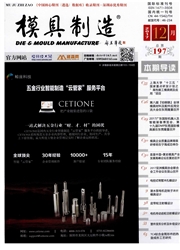

 中文摘要:
中文摘要:
采用硬度仪、光学显微镜、冲击试验机、扫描电镜及XRD研究分析了淬回火工艺对压铸模具用4Cr5M02V钢强韧性及组织的影响。结果表明:1,030℃:和1,0609(2淬火并经560℃回火后试样的韧性达到峰值416.8J和406.1J,高于经1,0009(2淬火560℃回火后试样的冲击韧性值339.5J,1,0009C淬火580℃回火冲击韧性值达到峰值366.6J。XRD分析表明,回火温度为480℃时,碳化物主要为V6C5、V8C7,经500℃回火后,开始出现VC。520℃回火出现二次硬化现象,在保温时间到达到2h时,硬度最高为54.7HRC,后随保温时间延长,硬度下降。VC的析出导致了二次硬化现象。在480℃~580℃回火,随着回火温度的提高,冲击韧性随之上升,当温度超过580℃后,冲击韧性开始下降。
 英文摘要:
英文摘要:
The effects of quenching and tempering process on the strength, toughness and microstructure of 4Cr5Mo2V steel were studied in this paper. By the hardness tester, optical microscope, impact test machine, scanning electron microscope and XRD. The results showed that when quenching at 1030℃ and 1060℃ and then tempering at 560℃,the toughness reached 416.8J and 406.1J respectly, which was higher than that of quenching at 1000℃, impact toughness value is 339.5J.When tempering at 580℃ ,it reaches the peak value 366.6J. XRD analysis showed that when tempering at 480℃, the carbides are mainly V6C5 and V8C7. When tempering above 500℃, the VC carbide appears. When tempering at 520℃, it occurs the secondary hardening phenomenon. When the holding time reaches 2h, the highest hardness is 54.7HRC, and the precipitation of VC leads to this results. With tempering temperature increasing, the impact toughness increases when tempering at 480-580℃ , and the impact toughness begins to decrease when the tempering temperature is above 580℃.
 同期刊论文项目
同期刊论文项目
 同项目期刊论文
同项目期刊论文
 期刊信息
期刊信息
